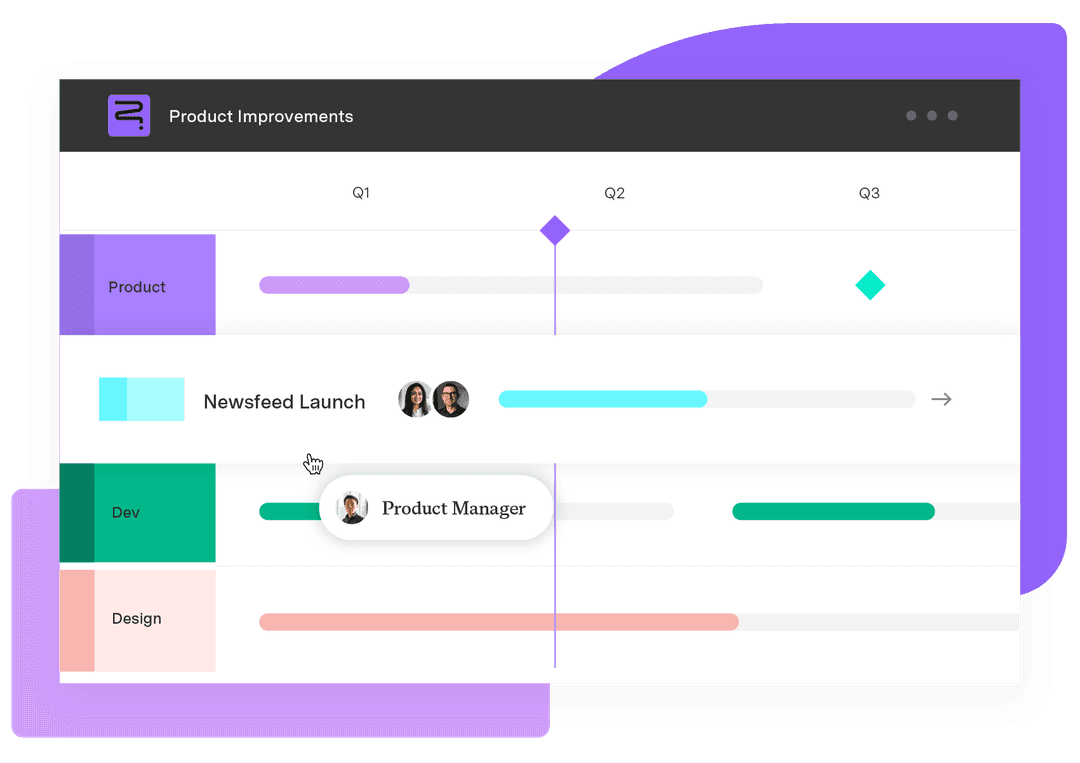What is agile project management? Methodology explained
Tempo Team
Project management is never as simple as following a step-by-step plan. Priorities shift, unexpected roadblocks pop up, and before you know it, that carefully crafted plan is completely outdated.
Sticking to a rigid structure only makes things worse. It slows teams down, and the lack of adaptability means the project may not even fulfill users’ needs by the time it’s complete.
Agile project management offers a different approach. Instead of locking themselves into a plan that may not hold up, agile teams break projects into smaller, manageable cycles. They collaborate, adapt, and improve as they go, so the outcome is precisely what users need.
What is agile project management?
At its core, agile project management is a flexible, iterative approach that focuses on collaboration, adaptability, and continuous improvement. Teams break projects into smaller, manageable cycles, called sprints, allowing them to gather feedback and refine their work as they go.
Traditional project management methodologies, like the waterfall method, follow a fixed, step-by-step plan that makes changes difficult once work has begun. Agile processes work differently, asking teams to organize tasks in a product backlog, prioritize based on customer needs, and use frameworks like Scrum and Kanban to stay on track.
Agile project management aims to deliver value faster, adapt to change, and guarantee the final product meets real-world needs. Whether applied to agile software development or other industries, an agile approach empowers teams to be more responsive and customer-focused.
Benefits of agile project management
Agile project management is about delivering better results, faster. With emphasis on flexibility and continuous improvement, agile methods help teams track work, manage risks, and align projects with business goals. Here’s how:
Efficient progress tracking: Agile practices maintain clarity by breaking work into manageable pieces and making progress visible. This transparency keeps project managers, team members, and stakeholders aligned.
Fast, predictable delivery: An agile team’s development process works in iterations and steadily delivers small pieces of the project. Regular sprint reviews and retrospectives fine-tune the process, making the team faster and more reliable over time.
Effective risk management: Agile project management helps teams spot and address risks early via regular check-ins. They continuously assess progress and adjust plans to avoid potential problems rather than reacting to them.
Stakeholder engagement: Instead of working in silos, agile teams gather feedback throughout the project to keep everyone on the same page. Frequent check-ins, sprint reviews, and backlog refinements ensure work is relevant and valuable.
Alignment with business needs: Agile processes make adaptation easier, keeping teams focused on the most valuable work. An agile team constantly refines the backlog in response to feedback so priorities reflect the business’s current needs.
What are the four principles of agile project management?
The Agile Manifesto outlines four key principles that help teams work smarter, collaborate better, and adapt to change without losing momentum.
1. Individuals and interactions over processes and tools
Agile methods prioritize team members’ relationships and expertise over strict rules. Teams get better results when leaders promote communication, collaboration, and autonomy.
2. Working software over comprehensive documentation
Agile teams don’t wait for a clear path from start to finish before they begin work. Instead, they build, test, and improve as they go. They focus on delivering something useful, not just checking off documentation requirements.
3. Customer collaboration over contract negotiation
Agile project management emphasizes ongoing collaboration with stakeholders and end users throughout development to ensure the product truly adds value.
4. Responding to change over following a plan
Agile practices embrace change, allowing teams to pivot when needed. Teams work in sprints, regularly reassessing priorities and holding sprint reviews so they aren’t trapped by a plan that no longer works.
Types of agile methodologies
Various agile frameworks exist to serve different teams, priorities, and projects. Here are some of the most popular methods and how they work:
Scrum
Scrum organizes work into short, focused sprints (typically two to four weeks). Each sprint starts with sprint planning. This plan is updated during daily scrums (aka check-in meetings), ending with a sprint review and retrospective to refine the process. A scrum master guides the team so they stay on track and continuously improve.
Kanban
Kanban is a visual workflow system that keeps tasks moving. Teams use a Kanban board to track progress, shifting tasks from “To Do” to “In Progress” to “Done.” There are no fixed sprints; work happens continuously, making Kanban ideal for teams handling high volumes or unpredictable tasks.
Lean
Lean focuses on efficiency by cutting unnecessary steps and streamlining the development process. If something doesn’t add value, it’s eliminated to make workflows leaner. This helps teams move faster and deliver better results with fewer resources.
Extreme programming (XP)
Extreme programming (XP) helps agile software development teams deliver high-quality code quickly. It emphasizes quick feedback and best practices like pair programming, test-driven development, and continuous integration.
Adaptive project framework (APF)
An adaptive project framework (APF) thrives in uncertain environments. Teams test different approaches, gather stakeholder feedback, and adjust as needed. This method works well when customers’ needs change regularly.
How to implement agile project management in 5 steps
Implementing agile project management is about shifting how teams think, collaborate, and adapt. Here’s how to put agile into action:
1. Strategic project planning
Every project starts with a goal. In agile methodology, planning focuses on high-level objectives rather than rigid, long-term plans. Teams define a clear vision, outline key deliverables, and set broad timelines that allow for flexibility.
This stage also includes identifying stakeholders and determining which agile framework (e.g., Scrum, Kanban, or Lean) best fits the project’s needs.
2. Product roadmapping
A product roadmap acts as a guide, outlining the product’s development and the features or deliverables teams must complete over time. Unlike traditional roadmaps, agile roadmaps evolve based on feedback and shifting business priorities.
Teams create a product backlog, listing all potential tasks and user stories. The backlog helps prioritize work so development efforts align with customer needs and business goals.
3. Release plan coordination
Agile teams release work in small increments instead of waiting until they finish the entire project. These releases allow for early feedback and continuous improvements.
Scrum teams typically work in sprints, whereas Kanban teams focus on maintaining a steady flow of tasks using a Kanban board. In both cases, they break work into manageable cycles for continuous delivery.
4. Structured sprint planning
Before each sprint, the team holds a sprint planning session, during which they define tasks for the upcoming cycle, estimate the required effort, and assign responsibilities.
Clear sprint goals keep the team focused, and daily stand-ups (or daily scrum meetings) make sure progress stays on track. The goal is to produce a functional increment of work at the end of every sprint.
5. Sprint review and reflection
At the end of each sprint, teams hold a sprint review to showcase their work and gather stakeholder feedback. This verifies that deliverables align with expectations.
Teams also conduct a sprint retrospective, reflecting on what went well, what didn’t, and how to improve the next sprint. Then, they start the cycle again, applying what they learned.
Elevate your project management with Tempo
Agile project management is all about flexibility, speed, and collaboration. To truly maximize its potential, you need the project management tools to keep your team moving forward.
With Tempo’s Strategic Roadmaps, you can map out your projects and clearly define your goals, giving your team the guidance they need to stay focused and deliver results. Tempo’s full suite of tools work together to help you implement Agile at Scale and manage complex projects across teams, ensuring smooth coordination and timely delivery.
Are you ready to take your agile project management to the next level? Get Tempo’s Agile at Scale playbook today and start expanding your agile practices like a pro.












































